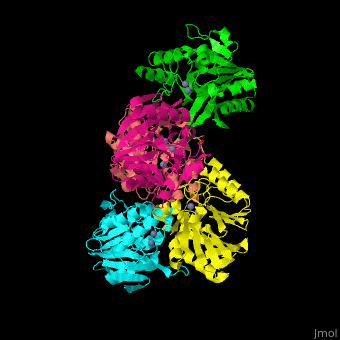Function
Beta-lactamase (Blac) are enzymes which make bacteria resistant to β-lactam antibiotics by breaking their β-lactam ring. Blac are classified according to their resistance targets.
- Class A are broad-spectrum. See also TEM1 Class Antibiotic Resistance Proteins.
- Class B are metalloenzymes. See also New Delhi metallo-β-lactamase 1.
- Class C are cephalosporinases. See also Class C beta-lactamase.
- Class D are cloxacilanases
- Carbapenemase (Car) are Blac with wide hydrolytic capacities. Car can hydrolyze penicillins, cephalosporins, monobactams and carbapenems.
- Extended-spectrum Blac class A (ESBL) hydrolyze penicillins but not cephalosporins.
- Serine beta-lactamase (ClbP) has a serine-active site.
- AmpC beta-lactamase (ClbP) mediate resistance to cephalosphin, cefazolin,cefoxitin and most penicillins[1].
Relevance
Blac makes some bacteria resistant to antibiotics like penicillin, cephamycin and carbapenems.
Structural highlights
The .[2]
See also
Journal:Structure:1
3D Structures of Beta-lactamase
Beta-lactamase 3D structures

